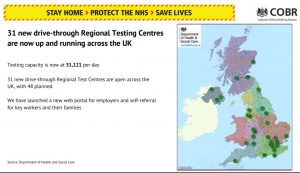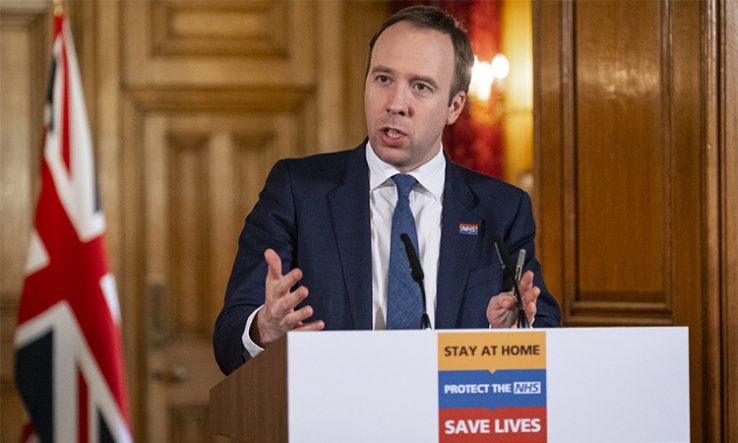John Lister –
Matt Hancock’s sudden conversion on April 23 to the cause of mass tracing of contacts of people infected by Covid-19 and commitment to recruit and train upwards of 18,000 people to begin this process “within weeks” is a belated victory for the public health professionals who have been screaming the need for this ever since contact tracing was abandoned in early March.
But the failure for so long to track and trace and to build the networks necessary to do this effectively has contributed to the spread of the virus and prolonged the lockdown of the economy.
Following on the exposure of the chaos and broken promises on supply of personal protection equipment (PPE) to NHS and social care staff, this additional failure of government policy is moving centre stage, as the deadline to hit the target of 100,000 daily tests for the Covid-19 virus is just a week away, with only around 23,000 tests being delivered, despite claims of capacity to test up to 50,000 daily.
As this Lowdown article is completed (April 24) despite initial plans for “up to 50” drive through testing centres to cover the whole of England, and plans now announced to expand from 31 centres to 48, there is no definitive list published by the Department of Health and Social Care or by Public Health England of centres planned or functioning.
A vague low-res map has been produced for those who can find it online, showing that of the actual centres established just one is in Wales, three each in Scotland and Northern Ireland, leaving just 24 to cover the whole of England, with huge areas lacking any testing centre. And people attempting to book themselves a test are promised a chance to choose where to be tested as they wade through the complex online process.

Meanwhile the Daily Mail has been highlighting the fact that many of those that have opened have few if any punters to test, not least because of the difficulties of getting to and from the test sites, while the Guardian has reported “severe failings” at the Chessington World of Adventure site, run by Deloittes.
Testing pledges
Promises to “ramp up” testing to 10,000 tests per day were made by NHS and Public Health England on March 11 along with a commitment to increase the number of testing centres across the country, “to help people get care quickly or have their mind put at ease.”
But the following day the government announced that its early work to track and trace everyone suspected of having the virus – the proven public health approach – was to be ended, and any attempt to keep track of infection was abandoned, while schools remained open, and mass gatherings were allowed to continue to the weekend. The government’s chief scientific advisor Sir Patrick Vallance put forward the notion of building up “herd immunity”.
A week later (March 18), with tests only running at around 4,000 a day, a government press release announced that testing would increase to 25,000 per day within four weeks, along with claims that Boris Johnson and Matt Hancock had “promised industry leaders that they would be given whatever support they need to help government increase testing capabilities across the country.”
The press release quoted Matt Hancock’s immodest claim that “We are already among the best in the world for coronavirus testing and today we are launching a national effort to increase our testing capability even further.” It’s not sure which other countries in the world Hancock was referring to.
But on March 31, almost 3 weeks after the initial promise was made, a comment article in the Metro asked the obvious question “where are coronavirus testing facilities?”
It appears that the most definitive list they could offer was a list of ten centres, eight of which were in England, three of them in London, plus one each in Wales (Swansea) and Scotland (Edinburgh). The rather curious list included apparently small scale sites in Harpenden in Hertfordshire and Easingwold in north Yorkshire, and the article noted that centres had opened in Shrewsbury and Wolverhampton … only to close again, as a result of “government advice”.
A common theme to most of the larger sites is that they are difficult or impossible to access by public transport and appear entirely geared up for car drivers. The huge areas of the country with no local access to a testing centre would be faced with a stark choice of long and arduous car journeys – or no test.
The Metro also stressed that members of the public would not be tested at the centres without a referral – to be made by employers. The next day the Sun headlined on “chaos” at testing centres, with long queues in Wembley (IKEA) – and little if any activity Chessington World of Adventures, with staff, including those told to attend after ringing 111, being told they could not be tested without emails specifying a date and time.

100,000 by month end?
Despite this unpromising start Matt Hancock went on to announce in another press release (April 2) that “The UK will carry out 100,000 tests for coronavirus every day by the end of this month.”
As with PPE, where several reorganisations have taken place as promises were broken and the system was obviously failing, a new figurehead was also brought in, presumably to take the blame when Hancock’s foolhardy promise is not delivered. Professor John Newton the Director of Health Improvement for Public Health England, was appointed as “testing coordinator” to “help deliver the new plans and bring together industry, universities, NHS and government behind the ambitious testing targets.”
Hancock also revealed a vague and repetitive “five pillar plan”:
• Scale up swab testing in PHE labs and NHS hospitals for those with a medical need and the most critical workers to 25,000 a day in England by mid to late April …
• Deliver increased “commercial swab testing” for critical key workers in the NHS across the UK …
• Develop blood testing to help know if people across the UK have the right antibodies and so have high levels of immunity to coronavirus;
• Conduct UK-wide surveillance testing … and
• Create a new National Effort for testing …
The obvious common fact of all five pillars is increased testing. But the growth has been slow and uncertain, not helped by constant top-level self-deception and PR spin.
On April 3, as complaints grew from NHS staff unable to get tests and therefore forced to self-isolate and miss work, Public Health England boss Duncan Selbie made an improbable claim: that “Thanks to PHE’s scientific capability … every hospital patient that requires a test has received one.”
Selbie, apparently unaware of the 100,000 daily target set the day before by Hancock, went on to claim that “we … are well on track to reaching 25,000 tests per day – or 750,000 tests per month – by the end of April.”
On April 6 NHS England’s medical director for primary care, Dr Nikki Kanani said testing for primary and community services was now being organised at a regional and system level: “so an STP or ICS level – and the testing is now being delivered through both a combination of NHS trusts and PHE.”
However there is little or no evidence on their websites of this being taken on by STPs, ICSs or hospital trusts. STP websites are notable for being virtually derelict, with little if any update since the end of last year. ICS sites seem to offer no information on testing.
A further government press release on “getting tested” for Covid-19, updated on April 17 displays a long and repetitious list of categories of people who they are “now testing”: the list includes
• All NHS and social care staff “including hospital, community and primary care, relevant staff providing support to frontline NHS services, and voluntary workers”
• Police fire and rescue services
• Local authority staff
• Staff working in children’s care
• Defence, prisons and judiciary staff
• “Other frontline workers as determined by local or national need.” Examples include:
“testing infrastructure workers (such as laboratories); workers in the funeral industry and coroners; and frontline Home Office and Border Force staff.”
The press release states that “Employers of frontline workers will be provided with information on how to make an appointment for their staff through their local resilience forum … their associated national department or agency, or directly through the Department of Health and Social Care.”
However, while testing for patients and NHS workers may be provided in some hospitals or NHS facilities, an unresolved issue remains where the bulk of the tests should be carried out – with a network of “up to 50 regional testing sites by the end of April.”
available to everybody who needs it”
On April 17 Hancock told the Commons health and social care committee that testing was “available to everybody who needs it across the NHS,” and that the 22 drive through testing centres in operation had been “big policy successes.” This success does not seem to have been reflected on the total of just 50,000 people who had been tested for coronavirus.
Numerous complaints
Nor is it clear that all test centres are open to all of the categories of workers listed by the DHSC: on April 19 for example the Telegraph complained care staff from Norfolk were being required to travel to Sheffield for tests, despite the establishment of a centre in Norwich Research Park for NHS staff. There have also been complaints of care staff having to drive from Dorset to Gatwick airport for testing – a near 300-mile round trip, while plans are discussed for a potential testing site in Bournemouth or Poole.
BMA GP committee chair Dr Richard Vautrey has warned there are challenges in some parts of the country with access to the 27 testing facilities, as GPs complained that the location of test sites required journeys of an hour or more to be swabbed. The BMA called for facilities to be set up in every CCG – four times the proposed number.
Recent announcements include a testing centre in Ebbsfleet to serve the large Kent area, where testing is currently confined to NHS hospitals testing only NHS staff. But the new centre is to be run not by the NHS, but contracted out to G4S – not a name that will inspire much confidence in care staff or other key workers. Testing at another new centre at an Oxford Park & Ride will be run by Boots and Serco.
The Guardian reports that the contracts for private companies to run the testing sites has been carried through without any competition, under the provisions of the 2015 Public Contract Regulations.
It looks like easy money for the contractors, since the workload is low, with little obvious accountability or regulation.
The Daily Mail has denounced “Britain’s coronavirus testing farce”, with pictures of deserted stadium and theme park car parks, fuming: “drive-through centres are only swabbing a handful of people every day – with a week to go to meet the Government’s pledge of swabbing 100,000 people a day.” The Sun argues that “Matt Hancock needs to stop pretending his coronavirus testing strategy is anything but a fiasco”.
Channel 4 News has also picked up on the exchange in the Commons between Labour leader Keir Starmer and acting PM Dominic Raab, in which Raab boasted of having increased testing capacity to 40,000 per day. Channel 4’s Patrick Worrall comments: ”Let’s be clear: the target Matt Hancock set out was not to increase capacity to 100,000 tests a day, it was to actually do those tests. The target was set out in writing at the time and is still available on the UK government website.”
Now Hancock has announced a U-turn to re-establish tracking and tracing, and said that key workers can make their own appointments for testing via the government’s website rather than go through their employers. However the forms are complex and for much of the morning after this announcement the website was not working.
Even if the booking system works, without accessible testing sites, it seems that 100,000 target for tests each day is unattainable.
How will ministers spin their way out of that?
Dear Reader,
If you like our content please support our campaigning journalism to protect health care for all.
Our goal is to inform people, hold our politicians to account and help to build change through evidence based ideas.
Everyone should have access to comprehensive healthcare, but our NHS needs support. You can help us to continue to counter bad policy, battle neglect of the NHS and correct dangerous mis-infomation.
Supporters of the NHS are crucial in sustaining our health service and with your help we will be able to engage more people in securing its future.
Please donate to help support our campaigning NHS research and journalism.


